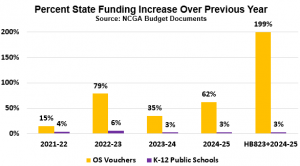
NC Private Schools Increase Tuition in Advance of Voucher Expansion
North Carolina’s voucher expansion may be driving private school tuition increases.
RALEIGH, NC, UNITED STATES, June 12, 2024 /EINPresswire.com/ -- The 2024-25 school year will be the first time North Carolina’s voucher program is available to all families regardless of income or whether students have ever attended a public school. Similar universal voucher eligibility in other states has exploded state budgets (e.g. Arizona) by adding a new line item - private school families whose children have never attended public school. In Arizona, 71% of the new voucher recipients (1) fall into this category.Reports show that universal vouchers may also add costs for private school families. A recent report from Princeton documents average tuition increases of 21-24% in Iowa’s private schools after voucher expansion. Arizona families also faced strikingly large tuition hikes (2).
North Carolina shows evidence of the same. While many private schools show a relatively steady tuition increase over recent years, early research (shown in the top chart) indicates that a number of schools have accelerated rates for 2024-25 (3). The purple bars in the chart show the percent increase in tuition from the 2023-24 school year to the 2024-25 school year for all grades served by the school. Red and yellow bars show the percent increases for the two previous years. No data label means that tuition rates were not available for the previous year, so increases could not be calculated.
For example, in 2021-22 the average tuition at Wayne Country Day School in Goldsboro ranged from $9,700 in kindergarten to $11,300 in grade 12. Across all grades, the average tuition was $11,038. For the next two years, tuition went up $350 each year in every grade (3%). But tuition for the 2024-25 school year went up an average of $1,838 (16%) and now ranges from $12,120 to $14,005 per student.
Long Shoals Wesleyan Academy in Lincolnton didn’t raise its average $4,323 tuition between the 2021-22 and 2022-23 school years. But tuition increased to an average of $4,523 in 2023-24 (5% increase) and to $6,123 for the 2024-25 school year (35% increase).
These data suggest that the new universal voucher availability may be creating incentives for schools to increase tuition rates. While families who receive vouchers may be able to absorb the tuition increases, those who don’t may feel pressure to apply for a voucher.
But these private schools may have put the cart before the horse. With universal availability and a flood of wealthy families seeking vouchers, applications reached a record high in North Carolina this year. Some applicants may not receive vouchers, leaving them with a higher tuition bill but no taxpayer voucher to make up the price difference.
The North Carolina Senate acted quickly in May to make sure new applicants were covered by passing House Bill 823 (along party lines) to add $248 million for 2024-25 and $215 million for 2025-26. This $563 million increase is on top of what’s already in the budget for vouchers. If these allocations make it through the current budget negotiations with the House, vouchers will see a 199% increase over 2023-24 funding. In comparison, as shown in the second chart, the K-12 public school budget increase currently stands at just 3%.
In the past few years, North Carolina’s Opportunity Scholarship voucher program has grown sharply, far exceeding the anemic spending increases for public schools, while school districts across the state face budget cuts as federal pandemic funding relief expires. In New Hanover County (4), budget shortfalls require staff to consider which positions they will be forced to cut if county commissioners don’t allocate enough funds to make up for lack of state funding. In the 2023-24 school year, New Hanover County’s direct payment schools—schools that accept vouchers— received a total of $2.4 million from the state for tuition payments. Since the voucher program began, more than $8.7 million dollars have gone to the county's private schools instead of public schools.
Cumberland County’s private schools have received more voucher dollars than any other North Carolina county. In 2023-24, Cumberland’s private schools received $18 million; since the voucher program began, private schools in Cumberland have received more than $69 million taxpayer dollars. Those funds could have instead supported public schools
The majority of North Carolina’s private schools are religious, often with strict limits on which students from which families (or churches) will be admitted. Voucher-accepting private schools also discriminate (5) on the basis of ability, gender, whether the student is LGBTQ+ or is a “right fit” for the school.
As private schools raise tuition in response to increased voucher availability, policymakers must evaluate whether public funds are appropriately spent on private school tuition and whether double-to-triple-digit increases are merited at the same time North Carolina’s public schools are struggling to make ends meet after years of paltry funding increases.
Heather Koons
Public Schools First NC
email us here
Visit us on social media:
Facebook
X
LinkedIn
Instagram
YouTube
TikTok
EIN Presswire does not exercise editorial control over third-party content provided, uploaded, published, or distributed by users of EIN Presswire. We are a distributor, not a publisher, of 3rd party content. Such content may contain the views, opinions, statements, offers, and other material of the respective users, suppliers, participants, or authors.



